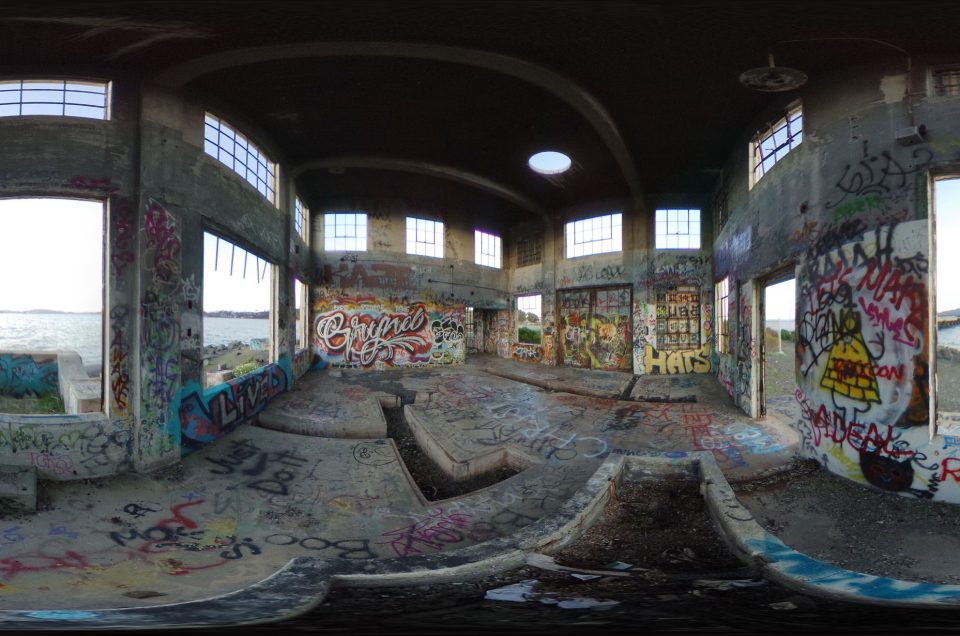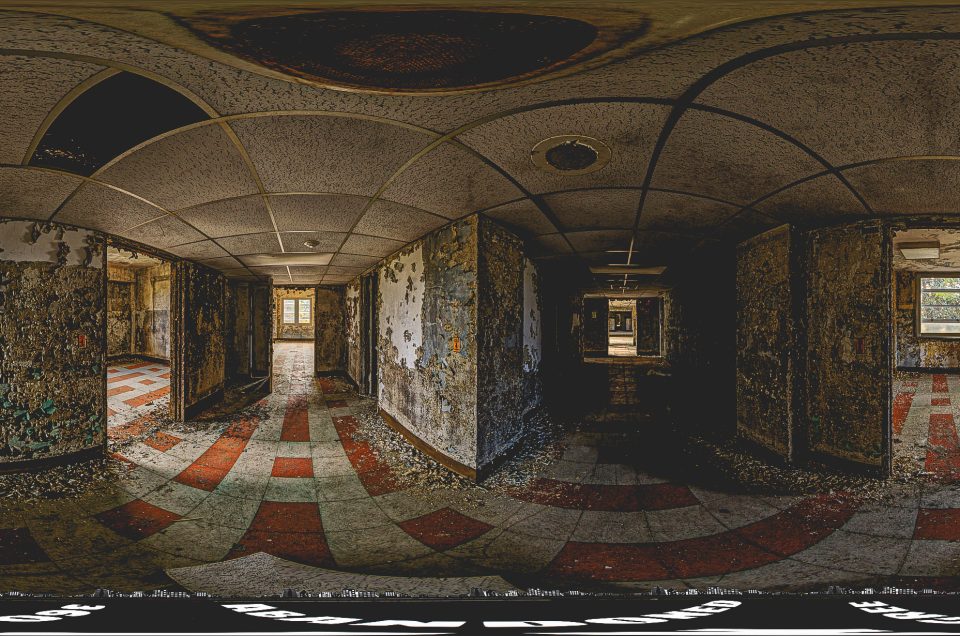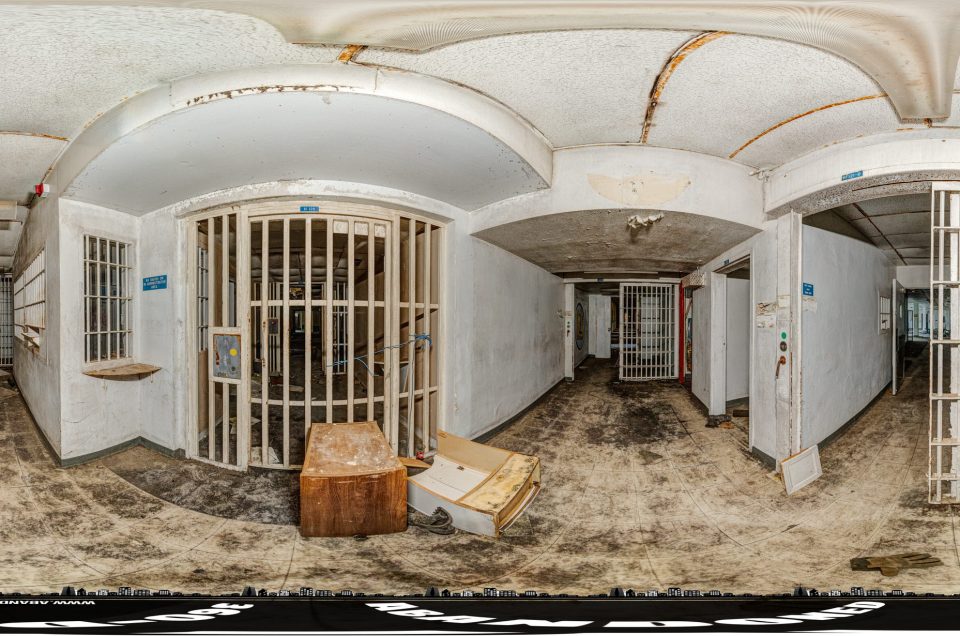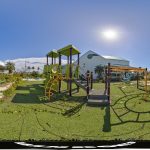Knoxville College: The Abandoned HBCU in Tennessee’s Urban Explorer Trail
Discover Knoxville College—an enduring landmark in Knoxville, Tennessee that speaks to generations of change, resilience, and architectural character. For urban explorers, the campus offers a rare glimpse of academic history meeting quiet decay, where brick facades, timeworn corridors, and storied classrooms hint at countless lives once lived here.
Ready to see it for yourself? Use the self-guided 360-degree panoramic virtual tour below to explore at your own pace, study details you might miss on foot, and appreciate the site with respect for safety and local laws.
Click here to view it in fullscreen.
A Once-Vibrant Campus Gone Still
Nestled in Knoxville, Tennessee, the Knoxville College campus stands eerily quiet today – a shell of its former self. This historically Black college (HBCU), founded in the 19th century, educated students for roughly 140 years before falling into decline and abandonment. Once alive with the energy of classrooms, dormitories, and student life, the 39-acre hilltop campus is now an abandoned in Tennessee landmark, drawing the curiosity of history buffs and urban explorers alike. Opened just a decade after the end of slavery to educate freed African Americans, Knoxville College was more than a school – it was a beacon of opportunity and progress. Today, its crumbling buildings and overgrown grounds offer an adventurous (and cautionary) journey into the past for those interested in urban exploring in Tennessee. In this blog, we’ll uncover Knoxville College’s rich history (including the year it was built and opened), its operating years and activities, the reasons it was abandoned, and its lasting historical significance. We’ll also provide safety tips, recommended URBEX gear, and legal considerations for anyone tempted to explore this haunting campus.
Founding of Knoxville College (1875): “Let There Be Light”
Knoxville College was established on December 16, 1875 by missionaries of the United Presbyterian Church of North America. The college’s early mission was clear – bring education to formerly enslaved men and women in East Tennessee. In fact, Knoxville College opened just ten years after slavery was abolished, as part of a broad effort to educate Black Americans in the Reconstruction era. The founders chose a hilltop site that once housed a Confederate battery during the Civil War, a symbolic transformation of a place of conflict into a place of learning.
The first building on campus, McKee Hall, was completed in 1876 and named after Reverend O. S. McKee – an early educator of Black students in the region. That December, Knoxville College opened its doors with great fanfare: local leaders like former Tennessee Governor William Brownlow spoke at the opening ceremonies, celebrating the birth of a new institution dedicated to Black education. In 1877, just a year later, the state of Tennessee officially designated Knoxville as a college (to the surprise of its first principal, who knew many students were still catching up on basic education). At its founding, Knoxville College was not just a college in name – it also operated elementary and high school-level classes to prepare students who had lacked earlier schooling. The motto “Let There Be Light” guided the school’s mission to illuminate minds that had long been denied formal learning.
Campus and Early Growth: The campus grew on a 39-acre plot overlooking Knoxville, eventually encompassing 17 buildings. Most of these structures were literally built by the hands of students. Early Knoxville College students manufactured bricks on campus – by 1904, over one million bricks had been made by students and either used in construction or sold to raise funds. The college’s chapel, for instance, was designed and built by a former student in 1913, using lumber donated by alumni. This self-sufficiency not only saved money but also taught practical skills in construction and trades – reflecting the school’s emphasis on industrial and vocational education alongside classical studies.
Academic Offerings: In its early decades, Knoxville College offered a broad curriculum. It began primarily as a normal school (teacher training institution), while also running an academy (primary and secondary school) for local Black children. As the college-level program took shape, students could pursue courses in the classics, sciences, and theology, as well as practical fields like agriculture, industrial arts, and even a short-lived medical program. Notably, between 1895 and 1900 the college operated a medical department for African-American students – an extremely rare opportunity at the time – which was initially aided by a donated “Colored Department” from the University of Tennessee’s medical school. Although the medical program closed by 1900, Knoxville College continued to innovate in Black higher education. By 1890, it was chosen to receive federal Morrill Act funds to provide agricultural and mechanical training to Black students in Tennessee. In effect, Knoxville College functioned as a land-grant institution for African Americans until a separate state-funded Black college was established years later.
Throughout the late 19th and early 20th centuries, Knoxville College expanded its facilities and reputation. A campus hospital and nurse training program were added in the early 1900s to serve the Black community’s health needs. By 1914, a dedicated College of Arts and Sciences was established, and in the interwar years the college became the leading supplier of Black teachers in East Tennessee. The elementary division was discontinued in 1927 and the high school in 1931 as the institution transitioned fully into a collegiate liberal arts focus. Despite challenges of segregation and limited funding, Knoxville College stood as a pillar of education for African Americans in the region.
Golden Years and Significance: “The Pride of East Tennessee”
By the mid-20th century, Knoxville College had come into its own as a respected HBCU. The school’s charter was eventually amended to integrate – allowing white students by the 1950s, after decades of operating under segregation (a Tennessee law in 1901 had forced all schools to be segregated). In 1957, Knoxville College became one of the first group of predominantly Black institutions admitted to full membership in the Southern Association of Colleges and Schools (SACS), achieving accreditation and recognition for its academic standards. The college was also a member of the United Negro College Fund, reflecting its importance among Black colleges nationally.
Student Life and Traditions: During its heyday, Knoxville College bustled with student life, sports, and traditions. The college’s athletic teams were known as the Knoxville College Bulldogs, donning garnet and blue school colors. Students could join fraternities, sororities, and clubs; the campus boasted a performing arts center, a gymnasium, a library, a student center, and the beautiful McMillan Chapel – all the fixtures of a thriving college community. Alumni from these years recall Knoxville College as a tight-knit environment “on the hill” (as locals nicknamed the elevated campus) where lifelong friendships were forged.
Civil Rights and Community Role: In the struggle for civil rights, Knoxville College played a pivotal role in East Tennessee. The campus became a hub of activism in the 1950s and 1960s. In the summer of 1960, Knoxville College students organized sit-in demonstrations to challenge segregated lunch counters in downtown Knoxville. Their persistent, peaceful protests led to most local businesses desegregating their eateries – a significant victory in the broader civil rights movement. That same year, the college hosted Dr. Martin Luther King Jr. as the commencement speaker for the Class of 1960, an event so momentous that it had to be held outdoors on the lawn to accommodate the large crowd. Dr. King’s presence and the activism of Knoxville College students underscored the institution’s reputation as a beacon of progress. The school’s contributions extended beyond its campus, serving as a backbone of the surrounding Mechanicsville neighborhood – a historically Black community in Knoxville. At its height in the early 1970s, Knoxville College enrolled over 1,300 students on its campus. It was a major gateway into the Black middle class of East Tennessee, producing generations of teachers, ministers, nurses, and community leaders who earned their education within its classrooms.
For many years, Knoxville College truly was “the pride of East Tennessee” for African Americans. Its historic buildings – many built by Black hands a century prior – were tangible symbols of perseverance and self-reliance. Eight of those structures (including McKee Hall, McMillan Chapel, Elnathan Hall, and others) are listed on the National Register of Historic Places, recognized as the Knoxville College Historic District for their architectural and historical significance. The very bricks in the walls were made by students, and the wood beams came from alumni donations – a legacy literally built from the ground up. Knoxville College taught its students to “let there be light,” and for many decades, it shone as a beacon of hope.
The Long Decline: Financial Struggles and Competition
By the 1970s, however, storm clouds were gathering over Knoxville College. The world around it had changed: after the civil rights era, Black students gained the freedom to attend predominantly white state universities, which often had better funding and facilities. Competition from larger, state-funded colleges began drawing potential students away from small private HBCUs like Knoxville College. The college found it increasingly difficult to recruit and retain students when nearby institutions could offer modern dorms, extensive programs, and scholarships supported by public funds. Additionally, Knoxville College’s salaries for faculty lagged behind, making it hard to keep top professors when wealthier universities could pay more. A slow decline in enrollment set in during the 1970s, gradually eroding the college’s financial base.
The 1980s brought more serious challenges. By 1982, severe budget shortfalls put Knoxville College on academic probation with its accreditor. In December 1984, SACS revoked the college’s accreditation due to the financial crisis, rendering its 560 students ineligible for federal financial aid. Losing accreditation was devastating – without it, students could not get grants or loans, and a college’s reputation would plummet. Knoxville College’s leadership and alumni rallied to save the school: a turnaround plan was implemented, debts were pared down, and remarkably, accreditation was regained by 1987. Enrollment even rebounded to over 1,200 students by the late 1980s as confidence was temporarily restored. For a brief moment, it seemed Knoxville College had weathered the storm.
However, the respite was short-lived. The college expanded ambitiously by acquiring Morristown College (a small two-year HBCU in east Tennessee) in 1989, aiming to broaden its reach by operating a branch campus. This move stretched finances even thinner. By the mid-1990s, Knoxville College was once again in crisis. Mounting debt – about $4 million – and ongoing leadership and management problems led SACS to put the college on probation again in 1995. Enrollment had fallen to around 300 students by then, far below the numbers needed to sustain operations. In December 1996, Knoxville College lost its accreditation for the second (and final) time. This was essentially a death blow to the institution’s viability. The loss became official in 1997, and without accreditation the college could no longer offer federal financial aid, triggering an exodus of students and faculty.
Shuttered Campus: Knoxville College Closes Its Doors
After 1997, Knoxville College spiraled into a freefall. Enrollment, which had been over a thousand just a decade earlier, dwindled to double digits. Most of the athletic programs were canceled since there were no longer enough students to field teams or funds to support them – only a few activities like the dance team, choir, and debate team survived briefly into the late 90s. The school’s finances were in shambles; debts continued to accumulate, and at one point even basic utilities became hard to maintain. Faculty members went unpaid for periods, and many staff had to be laid off.
Despite all this, the college initially refused to simply shut down. In the early 2000s, Knoxville College attempted to hold on as a much smaller school. Astonishingly, by 2015 it was reported that the college still had 11 students enrolled total. Classes were being taught to a handful of dedicated students even though the campus infrastructure was collapsing around them. The alumni and trustees fought to keep Knoxville College’s legacy alive, hoping for a turnaround. A series of interim presidents and proposed revival plans came and went in the 2000s, but none could secure the millions of dollars required to restore the institution.
Final Collapse (2015–2017): By spring 2015, reality could no longer be denied. That April, Knoxville College’s leadership announced that all classes would be suspended after the Spring 2015 semester – there would be no fall classes – in order to “reorganize” and address the college’s problems. Essentially, the school was shutting down its academic operations on campus, at least temporarily. Around this same time, another crisis had come to light: the abandoned science laboratories on campus were found to be stockpiled with toxic chemicals and even radioactive materials, a hazardous legacy of years of neglect. In 2013, a scrap metal dealer’s radiation alarm was triggered by a discarded piece of lab equipment that came from Knoxville College – a gas chromatograph containing a radioactive source. This alarming discovery prompted authorities to inspect the campus science building, where they found thousands of leaking containers of chemicals, high levels of mercury contamination, and even preserved animal specimens left behind to rot. The Environmental Protection Agency had to conduct an emergency cleanup in 2014, at an estimated cost of $425,000 – a bill the already-indebted college could not pay. The chemical contamination was so severe that in May 2016 the Tennessee Department of Environment and Conservation recommended the campus be designated a state Superfund site for environmental remediation.
By 2016, Knoxville officials were also losing patience with the derelict campus. The city warned the college that 14 of its buildings were unsafe – roofs caving in, walls cracking, black mold and asbestos hazards – and ordered that repairs be made within 90 days or the buildings would be condemned. Firefighters had already been responding to numerous fires set by vandals or accidental blazes in the empty halls; by 2017, the local fire department had handled at least 30 fire calls on campus since it closed in 1997. Crews attempted to board up the buildings repeatedly, but trespassers kept finding ways in. The campus had become a magnet for trouble: broken windows, graffiti, and arson became commonplace as it sat largely unguarded. Under threat of condemnation, the college boarded up and vacated its last occupied buildings in early 2017 – including the historic Alumni Library and the McMillan Chapel, which had still been in partial use – because they no longer met safety codes. After that point, no classes would ever meet on the Knoxville College campus again.
In a last-ditch effort, Knoxville College’s trustees resumed a few classes online in 2018 after getting approval from state authorities to enroll students again. A tiny number of students enrolled in these online programs – literally one or two students at first – allowing the college to claim it was still alive academically. In fact, by 2019 the college celebrated a single graduate who completed an online degree, and in May 2022 three more students graduated. However, these small victories on paper did not change the on-the-ground reality: the physical campus remained abandoned, deteriorating, and largely unusable. As of 2017, classes have not been held on campus due to the building safety issues. Knoxville College, once a beacon of learning, has for all practical purposes become a ghost campus.
The Abandoned Campus Today: Decay and Haunting Remnants
Walking onto the Knoxville College grounds today feels like stepping into a time capsule of mid-century academia, now overrun by nature and neglect. The campus – officially private property but effectively uninhabited – is an urban explorer’s dream and a neighborhood’s nightmare at the same time. Weeds and vines climb the brick facades of century-old halls where students once hurried to class. Many buildings have gaping holes in their roofs; others are blackened by soot from past fires. Glass from shattered windows crunches underfoot in the hallways. Desks, chalkboards, lab equipment, and personal items were abandoned in place, giving the eerie impression that everyone left in a hurry and never returned. In the old science building, for instance, investigators found classrooms strewn with open textbooks, chemical flasks, and even mercury-laced specimens still sitting out years after the college closed. McKee Hall, the first building constructed in 1876, still stands – a stately brick structure atop the hill – though it has suffered from vandals and the elements over the years. The once-grand Elnathan Hall, built in the 1890s, met a tragic fate: in November 2024, this historic dormitory-turned-administration building was completely destroyed by a massive fire that raged through the night. Firefighters suspected arson in that blaze, which reduced the landmark to a smoldering pile of bricks and forced authorities to finally demolish its ruins for safety. Ironically, this was the second time Elnathan Hall burned – it had also caught fire once in 1896 and been rebuilt in 1898. Its loss in 2024 was a stark reminder that each passing year threatens to erase more of Knoxville College’s physical legacy.
Without funds to maintain or secure the property, Knoxville College has effectively become an open site. It’s not officially open to the public by any means, but over time the campus has been frequented by local youth, vandals, squatters, and curious explorers. The lack of security turned the college into a sprawling homeless encampment, a place where people seeking shelter moved into the empty dorms and classrooms. Sadly, this led to crime and unsafe conditions – the campus became “a nest for drug overdoses and crime,” according to reports, burdening the surrounding community with frequent emergency calls. Since 2016, there have been over a thousand calls for police or fire assistance at the Knoxville College site, from small fires to medical emergencies. In one grim incident, two bodies were discovered in one of the abandoned buildings, highlighting the tragic reality of what can happen in these unsecured spaces.
Despite these issues, the old campus retains a powerful atmosphere. Daylight reveals graffiti-covered walls and peeling paint, but also the beautiful architectural details of buildings like McMillan Chapel (with its tall white steeple) and Gilbert Library, reminders of a prouder past. At night, the silhouette of the ruined halls against the Knoxville sky invokes a sense of ghostly nostalgia. It’s no wonder that Knoxville College has become a notable site for urban exploring in Tennessee – those with a sense of adventure and respect for history are drawn to its story. Some explorers come searching for photo opportunities amid the decay: dusty pianos left in an auditorium, or sunlight streaming through a collapsed roof onto rows of torn-up theater seats. Others come simply to pay homage to an institution that meant so much to the community. In 2018, alumni volunteers and community members tried to clean up parts of the campus and board up access points, hoping to stabilize the situation. The Knoxville College board of trustees has not given up hope either – they’ve worked on getting more buildings added to the historic registry and applied for grants to possibly rehabilitate key structures. However, with the school still $1.8 million in debt and even owing back taxes to the city, progress has been slow. The college’s leadership is currently attempting to regain accreditation through a different agency and someday re-open, but candidly acknowledge it will be a long journey.
For now, Knoxville College remains in limbo – not fully dead, yet far from alive. Its historic district status provides some protection against outright demolition, but also underscores how endangered these buildings are. Preservationists list the campus among Knoxville’s most endangered historic places, and every new act of vandalism or accidental fire increases the risk that little will be left to save. Urban explorers who venture here today are literally wandering through a piece of history that is disappearing in real time.
Urban Exploration at Knoxville College: A Thrilling Step Back in Time
For the URBEX enthusiast, Knoxville College offers a compelling (if challenging) experience. Exploring this abandoned college is like reading a story written in brick, wood, and shattered glass. Each building has its own chapter: the science hall still faintly smells of chemicals, the chapel’s roof leaks sunlight onto pews covered in dust, the gymnasium floor is warped and littered with debris where athletes once played. You might find old trophies in a display case, or student graffiti from decades past scribbled on a dorm room wall. The juxtaposition of inspiring history and current decay is striking – you can almost hear echoes of a lecture or a choir practice as you walk through an empty corridor with paint peeling in sheets from the ceiling.
However, make no mistake: **urban exploring at Knoxville College is risky and should never be taken lightly. This isn’t a casual tourist attraction; it’s a hazardous environment that has been officially closed for years. The buildings are in various states of disrepair – floors can be rotten or collapsed, staircases may be unstable, and ceilings have caved in many areas. There are environmental hazards too: asbestos insulation and lead paint in the old structures, residual chemical contamination in the science facilities (despite cleanup, who knows what lingers), and possibly biological hazards like mold or animal droppings. Additionally, given the site’s history as a homeless refuge, you could encounter other people on the property, some of whom might not welcome intruders. Knoxville College’s abandoned buildings have seen vandalism, arson, and even instances of illicit activity, so an explorer must stay alert and cautious at all times.
That being said, those who venture (legally, with permission – see below) onto the campus often describe it as a profoundly moving experience. It’s not just another abandoned building; it’s an abandoned legacy. Seeing the hand-crafted brickwork that students made a century ago, or the commemorative plaques on the wall honoring past presidents, brings home the reality of how important this place once was. The silence inside the former library or classroom is heavy with meaning – a mix of sadness and reverence. For photographers, the contrast of academic grandeur and decay provides endless creative shots. Sunlight filtering through broken stained-glass windows in the chapel can be hauntingly beautiful. Many URBEX photographers have documented Knoxville College’s ruins, capturing images of old chemistry lab beakers covered in dust, rows of seats in the auditorium slowly being reclaimed by nature, and ivy creeping into offices where deans and professors once sat.
If you plan on urban exploring in Tennessee and have Knoxville College on your radar, it’s essential to prepare thoroughly. Below, we’ll outline some safety tips, gear recommendations, and legal considerations to keep in mind before you even think about setting foot on this or any abandoned site.
Safety Tips, Urbex Gear, and Legal Considerations
Exploring abandoned places like Knoxville College can be an adventure straight out of a post-apocalyptic movie, but safety must come first. Here are important tips and considerations for urban explorers drawn to this historic campus (or any similar site):
-
Do Your Research: Before you go, research the site’s current status. Is it actively patrolled or under renovation? In the case of Knoxville College, the property is owned by the college’s board of trustees and remains private property – it’s not open to public tours. Be aware of recent events (for example, the fires in 2024) which might have changed the landscape or increased security. Sometimes after major incidents, authorities step up patrols. Knowing what you’re walking into helps you plan accordingly.
-
Get Permission if Possible: The best and legal way to explore is to seek permission from the owners or authorities. Admittedly, obtaining permission to wander around a hazardous, condemned campus can be difficult. But remember that trespassing is illegal. Knoxville College’s campus, though abandoned, is not public land. Urban explorers have been arrested or fined for venturing into off-limits places. If you can’t get formal permission, understand you’re taking a legal risk by entering. Many explorers choose to admire from the perimeter to stay on the safe side of the law.
-
Never Go Alone: Use the buddy system. Bring at least one fellow explorer – someone who can help if you get injured or need to navigate unexpected challenges. Large, dark buildings can be disorienting, and having a partner means you can look out for each other. Plus, it’s just safer to have backup in case you encounter other people on site.
-
Essential Urbex Gear: Equip yourself with the right gear to protect against the environment. Sturdy boots with thick soles are a must – you’ll likely be walking on broken glass, nails, and uneven surfaces. Wear long pants and consider a durable jacket; this will help prevent cuts or scrapes from jagged debris or overgrown bushes. Gloves (cut-resistant work gloves) are highly recommended to protect your hands if you need to move obstacles or steady yourself on rough surfaces. A flashlight or headlamp with extra batteries is crucial – many interiors will be pitch dark, especially windowless rooms or basements. It’s wise to also carry a respirator or dust mask rated for particulates, because older buildings like these can have asbestos fibers, lead dust, mold spores, and other airborne nasties. A simple N95 mask is good; a half-face respirator with P100 filters is even better if you’re going into areas with lots of dust (for example, exploring the old science labs or boiler rooms). Eye protection (safety goggles) can keep falling dust or cobwebs out of your eyes in tight spaces. And of course, bring a fully charged cell phone (and keep it on silent) – not just for photos, but in case you need to call for help. Lastly, a first aid kit in your backpack is a smart addition; include bandages, antiseptic, and anything you might need if you take a tumble.
-
Be Mindful of Hazards: Once on site, move slowly and deliberately. Every step in an abandoned building could conceal hazards. Test floors before putting full weight on them – if wood is rotted, it might give way. Avoid staircases that look decayed or unstable; collapsing stairs are a common cause of injuries in these places. If a room is filled with water (common if roofs leak), be careful of electricity – though Knoxville College likely has no power, there could be old wiring or other submerged hazards. Do not touch old chemical containers or unknown substances; in the science building, there were literally mercury spills and unlabeled chemicals, which can be dangerous. Vandals have also been known to booby-trap or leave sharp objects in some notorious urbex sites (like boards with nails, etc.), so keep your eyes open for any signs of intentional hazards. In Knoxville College’s case, also be alert for any lingering security measures – sometimes, even if owners can’t guard a place full-time, they may install alarm sensors or cameras in certain buildings to deter intruders.
-
Respect the Site (“Take Nothing but Photos”): Urban explorers abide by a code: leave things as you found them. Do not vandalize, break doors, or take “souvenirs” from the campus. Not only is defacing a historic site disrespectful, but it also further harms a place that is already fragile. Knoxville College is listed on the National Register of Historic Places, which means any artifacts or architectural elements there are part of a protected historical record. Removing or destroying them isn’t just unethical; it could potentially be a crime. So, avoid the temptation to take that old yearbook or sign you found – document it in photos and leave it be for others to witness (if allowed in the future).
-
Stay Situationally Aware: Keep noise to a minimum and listen to your surroundings. If you hear footsteps or voices, it could be other explorers – or law enforcement, or someone who shouldn’t be there. Have a plan for if you do run into police or security: it’s often best to cooperate, be honest, and calmly explain your interest in photography/history. Many urban explorers have had surprising luck just being respectful and being let off with a warning, but that’s never guaranteed. If you encounter hostile individuals (like copper thieves or squatters who may be territorial), it’s usually best to calmly make your exit. Your personal safety is more important than any exploration.
-
Weather and Timing: Visit in daylight if possible. While a nighttime explore might sound more thrilling, it exponentially raises the risks – you see less of the dangers, and it might be harder to explain your presence to police at 2 AM than in broad daylight with a camera. Also, avoid exploring during bad weather. High winds could bring loose roof pieces down, rain can make already slick surfaces treacherous, and lightning is a concern if you’re in a tall exposed structure. A dry, calm day is ideal.
-
Emergency Plan: Let someone not going with you know where you’ll be and when you expect to be back. That way, if something happens and you don’t return or check-in, they can alert authorities with your last known location. This simple step can be a literal lifesaver if you get injured and can’t get out on your own. Additionally, identify the nearest hospital before you go, just in case an injury does occur and you need to seek medical help afterward (for example, if you suspect you inhaled something toxic or got a deep cut).
Exploring Knoxville College can be an incredibly rewarding experience for those passionate about history and adventure. The site offers a rare glimpse into a bygone era of education, set against the poignant backdrop of nature reclaiming man-made structures. But it’s also a sobering lesson in the fragility of institutions – how a once-proud college could fall into ruin due to financial hardship and neglect. Urban explorers who tread carefully here do so not to glorify decay, but to document and remember what might soon be lost forever.
Conclusion: Legacy of Knoxville College
Knoxville College may be abandoned, but it is not forgotten. Its legacy lives on in the countless alumni whose lives were shaped on this campus, and in the history books as a landmark institution for African Americans in Tennessee. The story of Knoxville College is one of rise, struggle, and fall – from its hopeful founding in 1875 to its prominence in the mid-20th century, and then to its heartbreaking decline by the 2010s. Visiting the silent campus today, one can’t help but imagine the laughter of students on the lawn, the hymns once sung in the chapel, and the lectures that echoed through those now-empty halls. As urban explorers or history enthusiasts, we have a responsibility to treat such places with respect. Knoxville College’s buildings may crumble, but through photographs, stories, and preservation efforts, the memory of this HBCU will endure.
In the end, Knoxville College stands as a cautionary tale about the importance of sustaining our educational institutions – and as an unforgettable destination for those drawn to the adventure of exploring abandoned places. Whether you view it from behind a safety fence or carefully step inside (with permission and protection), the experience is likely to leave a lasting impression. Knoxville College is not just “abandoned in Tennessee”; it’s a piece of American history frozen in time. For the urban explorer, it offers both a thrill and a lesson: that every abandoned building was once filled with life, and every exploration is a chance to honor that past even as we seek out the secrets it has left behind.
If you thought this blog post was interesting, you might be interested in learning about the Telfair Regional Hospital in Georgia, the The Beach Water Park in Tennessee, or the Hotel Monte Palace in Portugal.
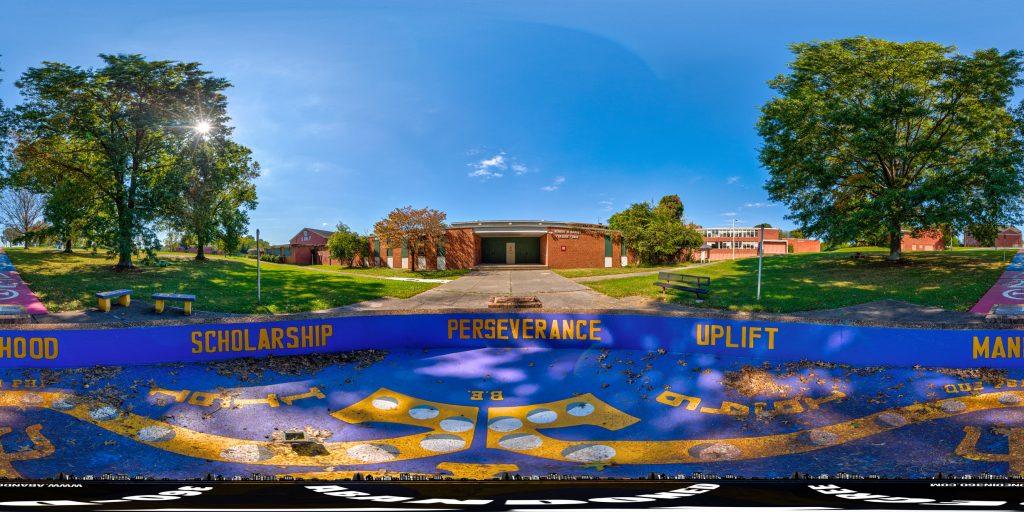
A 360-degree panoramic image captured at the abandoned Knoxville College in Knoxville, Tennessee. Photo by the Abandoned in 360 URBEX team.
Welcome to a world of exploration and intrigue at Abandoned in 360, where adventure awaits with our exclusive membership options. Dive into the mysteries of forgotten places with our Gold Membership, offering access to GPS coordinates to thousands of abandoned locations worldwide. For those seeking a deeper immersion, our Platinum Membership goes beyond the map, providing members with exclusive photos and captivating 3D virtual walkthroughs of these remarkable sites. Discover hidden histories and untold stories as we continually expand our map with new locations each month. Embark on your journey today and uncover the secrets of the past like never before. Join us and start exploring with Abandoned in 360.
Equipment used to capture the 360-degree panoramic images:
- Canon DSLR camera
- Canon 8-15mm fisheye
- Manfrotto tripod
- Custom rotating tripod head
Do you have 360-degree panoramic images captured in an abandoned location? Send your images to Abandonedin360@gmail.com. If you choose to go out and do some urban exploring in your town, here are some safety tips before you head out on your Urbex adventure. If you want to start shooting 360-degree panoramic images, you might want to look onto one-click 360-degree action cameras.
Click on a state below and explore the top abandoned places for urban exploring in that state.
